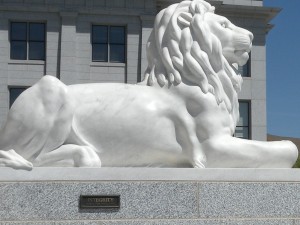» posted on Thursday, May 10th, 2012 by Linda Lou Burton
Integrity and Fortitude
 Linda Burton posting from Salt Lake City, Utah – Integrity met me as I climbed the steps. I’d parked across the street from the east entrance to the Utah State Capitol; walked the long sidewalk past the statue of the Indian Massasoit; and wondered about the two marble lions that watched my approach. Now I see; Integrity is to my right, Fortitude sits on the left. Inside, I blink as my eyes adjust to the cool gray interior, pleasant after the brilliant sun outside. A school tour is happening, children’s voices echo just a bit; greeters to my right ask if they can answer any questions or help with anything. I sign the Guest Book, pick up a colorful brochure; diagrams and paragraphs explain the opportunities; I plan out what I want to see. The door to the Capitol Visitor Center is beside me; I step in and see a boldly-lettered statement on a post.
Linda Burton posting from Salt Lake City, Utah – Integrity met me as I climbed the steps. I’d parked across the street from the east entrance to the Utah State Capitol; walked the long sidewalk past the statue of the Indian Massasoit; and wondered about the two marble lions that watched my approach. Now I see; Integrity is to my right, Fortitude sits on the left. Inside, I blink as my eyes adjust to the cool gray interior, pleasant after the brilliant sun outside. A school tour is happening, children’s voices echo just a bit; greeters to my right ask if they can answer any questions or help with anything. I sign the Guest Book, pick up a colorful brochure; diagrams and paragraphs explain the opportunities; I plan out what I want to see. The door to the Capitol Visitor Center is beside me; I step in and see a boldly-lettered statement on a post.
“The powers of the government of the State of Utah,” it begins. There are statements on the walls as well; excerpts from the Utah Constitution, 1896. Utah became the 45th state on January 4, 1896; Grover Cleveland was president. I see his name on the wall to my left. “Sensible and responsible women do not want to vote. Grover Cleveland, 1905.” Directly below follows this statement — “The rights of the citizens of the state of Utah to vote and hold office shall not be denied or abridged on account of sex. Utah State Constitution 1896, Article IV, Section I.” Like most western states, Utah granted voting rights to women long before the US Constitutional Amendment of 1920, preceded only by Wyoming and Colorado. “Did Grover grumble over that?” I wondered to myself. 
A bright mural on the far wall gives the timeline of Utah statehood; it took 47 years and seven tries in all, I read. I turn to another statement; “The Legislature shall provide for the establishment and maintenance of a uniform system of public schools, which shall be open to all children of the state and be free from sectarian control. Utah State Constitution 1896, Article X, Section 1.” Further description of the types of schools continues. I’m thinking about those school children touring upstairs now and wander out, to tag along behind and listen to what  they have to say. Some are wiggly, some are squinting in an upward stare, some are nodding as the tour guide points.
they have to say. Some are wiggly, some are squinting in an upward stare, some are nodding as the tour guide points.
I spot a stunning modern painting on an upper balcony. Right beside a placard reads “March 9, 1899, Senate Bill 89 sponsored by Representative Alice Merrill Horne was passed creating the Utah Art Institute, the first state-sponsored arts organization in the United States.” Well I’ll be darned. Alice did her job, there is art everywhere you look – in the form of murals and paintings, marble busts and bronze sculptures. I think back to my meeting with Integrity, that good-hearted lion who welcomed me in. There are four lions in all, I learn; Honor and Patience sit at the west entrance. Each lion represents not only a desirable virtue but a phase of life; Integrity the middle stage; Fortitude the last. Appropriate, I think. As I go back out, I give the Elder Fortitude a loving pat.
http://utahstatecapitol.utah.gov/
http://www.archives.state.ut.us/research/exhibits/Statehood/1896text.htm
The monumental bronze sculpture at the East Entrance of the Utah State Capitol was created by nationally recognized sculptor Cyrus E. Dallin (1861-1944), a native of Utah. Massasoit was the Wampanoags Nation Chief who first welcomed the Pilgrims at Plymouth Rock after they disembarked from the Mayflower. Dallin, who did more than 260 works in his lifetime, created the sculpture in the 1920’s and is known internationally for his realistic rendering of Chief Massasoit as well as the Angel Moroni statue that sits on top of the Salt Lake City Temple, and the equestrian statue of Paul Revere in Boston.
“These (Utah) mountains are linked with the story of the Indian,” Dallin said. “In setting up this man of peace, who saved the Plymouth Colony, I have a hope…that I might model the old Chief Washakie of the Shoshones, who, too, was a man of peace; and he wielded as potent and saving an influence over the first Pioneers…as ever did Massasoit over the Pilgrims.”

